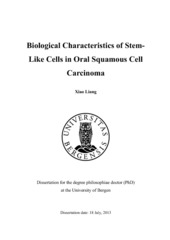| dc.contributor.author | Liang, Xiao | en_US |
| dc.date.accessioned | 2013-09-10T07:44:44Z | |
| dc.date.available | 2013-09-10T07:44:44Z | |
| dc.date.issued | 2013-06-18 | eng |
| dc.identifier.isbn | 978-82-308-2328-6 | en_US |
| dc.identifier.uri | https://hdl.handle.net/1956/7091 | |
| dc.description.abstract | It has been shown that many solid malignancies, including oral squamous cell carcinoma (OSCC), contain a small population of tumorigenic cells referred to as cancer stem-like cells (CSCs) or tumor initiating cells (TICs). The concept of stem cell hierarchy in cancers, coupled to the phenomenon of epithelial-to-mesenchymal transition (EMT), seems to explain well the biology of most cancers, as well as the failure of the currently used therapeutical methods. Nevertheless, more evidence is needed for understanding of both these concepts as well as the relationship between them in cancer in general, and in OSCC in particular. By using marker-based fluorescence-activated cell sorting (FACS), the most commonly used method for isolation of CSCs, we aimed to investigate whether there is a link between CSCs and the EMT phenomenon in OSCC-derived cell lines and primary cells (Paper I). Subpopulations of cells were sorted by FACS using their differential expression of the CD44 adhesion molecule and epithelial specific antigen (ESA), and then investigated for stem cell and EMT properties both in vitro and in vivo. Our findings showed that the CD44high fraction of CSCs contained (1) an ESAhigh fraction which was the holoclone-forming population and had more epithelial characteristics (EPI-CSCs), and (2) an ESAlow fraction which was more migratory and formed more spheres (EMT-CSCs). These two subpopulations of CSCs were able to swift between each other, although the EPI-CSC fraction was highly bipotent (~100%), while only a proportion of the EMT-CSC fraction was bipotent (≤ 50%). We further investigated whether the CSCs phenotype and the switch between the two phenotypes (EPI-CSCs and EMT-SCSs) can be modulated by external signals from stem cell niches such as neighboring stroma (Paper II). OSCC-derived cell lines and primary cells were FACS sorted into a subpopulation enriched for CSCs (CD44high) and a subpopulation depleted in CSCs (CD44low), and the effect of carcinoma associated fibroblasts (CAFs), one of the major components of tumor stroma in carcinomas, on self-renewal and tumorigenic abilities of these subpopulations was investigated. The results demonstrated that CAFs were capable to enhance the self-renewal and tumorigenicity of OSCC cells, and that TGF-β1 was the key regulator for this effect. Of most interest was the finding that CAFs induced clonogenic and tumorigenic abilities in the subpopulation of cancer cells depleted for CSCs, pointing to the need for all cell subpopulations to be targeted in cancers for successful therapy. Although FACS is used extensively for CSC sorting, the method might be prone to certain inconsistencies and a subjective way of gate setting, in addition to the fact that the antibody used for staining might modify the phenotype of cells when binding to them. Therefore we aimed to establish more functional and robust methods for isolation of CSCs (Paper III). The potential of a previously reported method for isolating normal epithelial stem cells using their differential adhesiveness to one of the main components of basement membrane, collagen IV, for CSCs enrichment was tested for OSCC-derived cells. Assessment of the biological properties of the subpopulations separated over different time according to their adhesiveness to collagen IV (RAC-10 min, MAC-30 min, and LAC-4 h) indicated that the rapid adherence to collagen IV can be used as a non-invasive and functional method to enrich for OSCC cells with increased colony and sphere forming ability, tumor formation ability and with high expression of stem cell-related markers (RAC). We also characterized these cells for their electrophysiological properties utilizing the technique of dielectrophoresis (Paper IV). The results showed that the subpopulation of RAC cells enriched for CSCs possessed differential electrophysiological properties when compared to the other subpopulations (MAC and LAC), and this was mainly due to their particular cell membrane morphology, very rich in cellular protrusions. In addition, this work suggested that CSCs in general might exhibit unique dielectrically features that can be putatively used in the future for their isolation, as a label-free and non-invasive method. | en_US |
| dc.language.iso | eng | eng |
| dc.publisher | The University of Bergen | eng |
| dc.relation.haspart | Paper I: Biddle A, Liang X, Gammon L, Fazil B, Harper LJ, Emich H, Costea DE and Mackenzie IC. Cancer stem cells in squamous cell carcinoma switch between two distinct phenotypes that are preferentially migratory or proliferative. Cancer Research 2011 Aug 1;71(15):5317-26. Article not available in BORA due to publisher restrictions. The published version is available at: <a href="http://dx.doi.org/10.1158/0008-5472.CAN-11-1059" target="blank">http://dx.doi.org/10.1158/0008-5472.CAN-11-1059</a> | en_US |
| dc.relation.haspart | Paper II: Osman AH, Liang X, Bilal F, Biddle A, Neppelberg E, Lybak S, Liavaag PG, Jacobsen H, Førde H, Vintermyr OK, Johannessen AC, Mackenzie IC, Wang J, Enger PO and Costea DE. Carcinoma associated fibroblasts promote a cancer stem-like cell phenotype through TGF-β1 secretion. Article not available in BORA. | en_US |
| dc.relation.haspart | Paper III: Liang X, Osman T, Sapkota D, Neppelberg E, Lybak S, Liavaag PG, Johannessen AC, Jacobsen H, Enger PO, Wang J and Costea DE. A functional approach for isolation and enrichment of oral cancer cells with tumor-initiating properties. Article not available in BORA. | en_US |
| dc.relation.haspart | Paper IV: Liang X, Graham K, Johannessen AC, Costea DE and Labeed FH. Human oral cancer cells with stem-like properties exhibit high effective membrane capacitance due to rich cell membrane surface protrusions. Article not available in BORA. | en_US |
| dc.title | Biological Characteristics of Stem-Like Cells in Oral Squamous Cell Carcinoma | en_US |
| dc.type | Doctoral thesis | |
| dc.rights.holder | Copyright the author. All rights reserved | |

